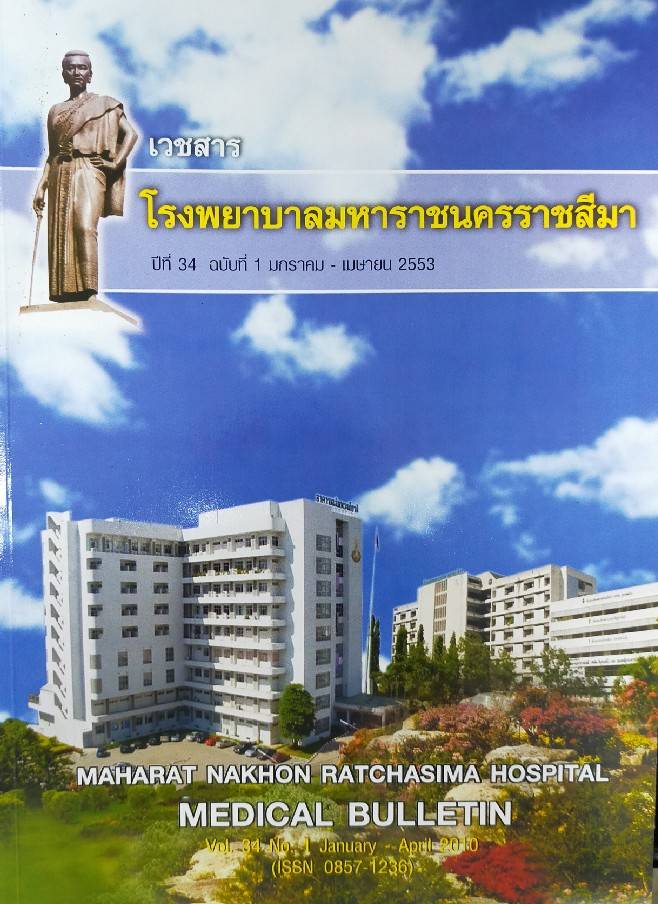Factors associated with Excessive Blood Loss and Blood Transfusion in Abdominal Hysterectomy for Benign Gynecologic Diseases
Main Article Content
Abstract
Background: Hysterectomy is a common major gynecological procedure. Though, it is quite safe for patients, intraoperative hemorrhage was found as the main complication. Objective: To determine the incidence of excessive blood loss (>500 ml) and blood transfusion in abdominal hysterectomy and factors associated with those incidences for benign gynecologic conditions. Patients & Methods: Retrospective descriptive study was conducted in 854 women who underwent total abdominal hysterectomy for benign gynecologic conditions at Maharat Nakhon Ratchasima Hospital between January 2008 to December 2009. Data were collected from patient medical records. Logistic regression analysis was performed to determine the independent factors that were associated with an increasing risk of excessive blood loss and blood transfusion. Results: The median blood loss was 250 ml (range 50-2,500). One hundred and eighty two (21.3%) patients had excessive blood loss. BMI > 25 kg/m2, diagnosis of endometriosis or tuboovarian abscess, uterine size >12 weeks, level of surgeon, s skill and pelvic adhesion were factors significantly associated with excessive blood loss. One hundred and three (12.1%) patients had intraoperative blood transfusion. Operative time >120 min, preoperative hemoglobin levels <12 gm/dL and pelvic adhesion were factors significantly related to blood transfusion. One hundred and nineteen (13.9%) patients had preoperative blood transfusion because hemoglobin level at admission was <10 gm/dL. Conclusion: The incidence of excessive blood loss in abdominal hysterectomy in Maharat Nakhon Ratchasima Hospital was 21.3%, intraoperative blood transfusion was 12.1% and pre-operative blood transfusion was 13.9%. The associated factors should be concerned since preoperative period to improve the surgical outcome.
Article Details

This work is licensed under a Creative Commons Attribution-NonCommercial-NoDerivatives 4.0 International License.
References
Spilsbury K, Semmens JB, Hammond I, Bolck A. Persistent High Rates of Hysterectomy in Western Australia: A Population-Based Study of 83,000 Procedures Over 23 Years. BJOG 2006; 113: 804-9.
Falcone T, Walters MD. Hysterectomy for benign disease. Obstet Gynecol 2008; 111: 753-67.
Jones III HW. Abdominal hysterectomy. In: Rock JA, Tones III HW, editors. Te Linde,s Operative gynecology. 10th ed. Philadelphia: Lippincott Williams & wilkins; 2008. p.727-43.
Wiladsakdanon S, Charoenkwan K. Predicting factors for excessive intraoperative blood loss during abdominal hysterectomy for benign gynecologic diseases. Thai J Obstet Gynaecol 2009; 17: 116-21.
Unger JB, Paul R, Caldito G. Hysterectomy for the Massive Leiomyomatous Uterus. Obstet Gynecol 2002; 100: 1271-5.
Hillis SD, Marchbanks PA, Peterson HB. Uterine size and risk of complications among woman undergoing abdominal hysterectomy for leiomyomas. Obstet Gynecol 1996; 87: 539-43.
Behtash N, Ghaemaghami F, Gilani MM, Rajabi MT, Moghimi R, Hanjani P. To peritonealise or not to peritonealise? A randomized trial at abdominal hysterectomy in Iran. Obstet Gynecol 2001; 21: 520-4.
Garry R, Fountain J, Mason S, Napp V, Brown J, Hawe J, et al. The evaluate study: Two parallel randomized trials, one comparing laparoscopic with abdominal hysterectomy, the other comparing laparoscopic with vaginal hysterectomy. BMJ 2004; 328: 129-36.
Isik-Akbay EF, Harmanli OH, Panganamamula UR, Akbay M, Gaughan J, chatwani AJ. Hysterectomy in obese women: A comparison of abdominal and vaginal routes. Obstet Gynecol 2004; 104: 710-4.
สุวันชัย ชัยรัชนียบูรณ์, หเทิญ ถิ่นธารา. ปัจจัยเสี่ยงของการได้รับเลือดในการผ่าตัดมดลูกทางหน้าท้องแบบไม่ฉุกเฉิน. สงขลานครินทร์เวชสาร 2542; 17: 91-5.
Walsh CA, Walsh SR, Tang TY, Slack M. Total abdominal hysterectomy versus total laparoscopic hysterectomy for benign disease: A meta-analysis. Eur J Obstet Gynecol Reprod Biol 2009; 144: 3-7.
Varol N, Healey M, Tang P, Sheehan P, Mahfr P, Hill D. Ten–year review of hysterectomy morbidity and mortality: can we change direction? Aust N Z J Obstet Gynaecol 2001; 41: 295-302.
Dicker RC, Greenspan JR, Strauss LT, Cowart MR, Scally MJ, Peterson HB, et al. Complication of abdominal and vaginal hysterectomy among women of reproductive age in the United States, The collaborative review of sterilization. Am J Obstet Gynecal 1982; 144: 841-8.
Peduzzi P, Concato J, Kemper E, Holford TR, Feinstein AR. A simulation study of the number of events per variable in logistic regression analysis. J Clin Epidemiol 1996; 49: 1373-9.
Rasmussen KL, Neumann G, Ljungstrom B, Hansen V, Lauszus FF. The influence of body mass index on the prevalence of complications after vaginal and abdominal hysterectomy. Acta Obstet Gynecol Scand 2004; 83: 85-8.
Reiter RC, Wagner PL, Gambone JC. Routine hysterectomy for large asymptomatic uterine leiomyomata: A reappraisal. Obstet Gynecol 1992; 79: 481-4.
Farquhar CM, Sadler L,Harvey S, McDougall J, Yazdi G, Meuli K. A prospective study of the short-term outcomes of hysterectomy with and without oophorectomy. Aust N Z J Obstet Gynaecol 2002; 42: 197-204.
Akingba DH, Deniseiko-Sanses TV, Melick CF, Ellerkmann RM, Matsuo K. Outcomes of hysterectomies performed by supervised residents vs those performed by attendings alone. Am J Obstet Gynecol 2008; 199: 673.e1- e6. ปัจจัยที่มีความสัมพันธ์กับภาวะเสียเลือดมาก และการได้รับเลือดทดแทน ในการผ่าตัดมดลูกทางหน้าท้องในโรคทางนรีเวชที่มิใช่มะเร็ง


